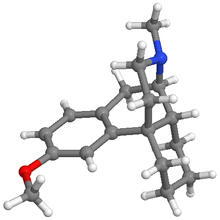Ionotropic
GABAA Tooltip γ-Aminobutyric acid A receptor
Positive modulators (abridged; see here for a full list): α-EMTBLAlcohols (e.g., drinking alcohol , 2M2B )Anabolic steroids Avermectins (e.g., ivermectin )Barbiturates (e.g., phenobarbital )Benzodiazepines (e.g., diazepam )Bromide compounds (e.g., potassium bromide )Carbamates (e.g., meprobamate )Carbamazepine Chloralose Chlormezanone Clomethiazole Dihydroergolines (e.g., ergoloid (dihydroergotoxine) )Etazepine Etifoxine Fenamates (e.g., mefenamic acid )Flavonoids (e.g., apigenin , hispidulin )Fluoxetine Flupirtine Imidazoles (e.g., etomidate )Kava constituents (e.g., kavain )Lanthanum Loreclezole Monastrol Neuroactive steroids (e.g., allopregnanolone , cholesterol , THDOC )Niacin Niacinamide Nonbenzodiazepines (e.g., β-carbolines (e.g., abecarnil ), cyclopyrrolones (e.g., zopiclone ), imidazopyridines (e.g., zolpidem ), pyrazolopyrimidines (e.g., zaleplon ))Norfluoxetine Petrichloral Phenols (e.g., propofol )Phenytoin Piperidinediones (e.g., glutethimide )Propanidid Pyrazolopyridines (e.g., etazolate )Quinazolinones (e.g., methaqualone )Retigabine (ezogabine) ROD-188 Skullcap constituents (e.g., baicalin )Stiripentol Sulfonylalkanes (e.g., sulfonmethane (sulfonal) )
Topiramate Valerian constituents (e.g., valerenic acid )Volatiles /gases (e.g., chloral hydrate , chloroform , diethyl ether , paraldehyde , sevoflurane )Negative modulators: 1,3M1B3M2B
11-Ketoprogesterone 17-Phenylandrostenol α5IA (LS-193,268) β-CCB
β-CCE
β-CCM
β-CCP
β-EMGBL
Anabolic steroids Amiloride Anisatin β-Lactams (e.g., penicillins , cephalosporins , carbapenems )Basmisanil Bemegride Bicyclic phosphates (TBPS , TBPO , IPTBO )BIDN Bilobalide Bupropion CHEB
Chlorophenylsilatrane Cicutoxin Cloflubicyne Cyclothiazide DHEA DHEA-S Dieldrin (+)-DMBB DMCM DMPC
EBOB Etbicyphat
FG-7142 (ZK-31906) Fiproles (e.g., fipronil )
Flavonoids (e.g., amentoflavone , oroxylin A )Flumazenil Fluoroquinolones (e.g., ciprofloxacin )Flurothyl Furosemide Golexanolone Iomazenil (123 I) IPTBO Isopregnanolone (sepranolone) L-655,708 Laudanosine Lindane MaxiPost
Morphine Morphine-3-glucuronide MRK-016 Naloxone Naltrexone Nicardipine Nonsteroidal antiandrogens (e.g., apalutamide , bicalutamide , enzalutamide , flutamide , nilutamide )Oenanthotoxin Pentylenetetrazol (pentetrazol) Phenylsilatrane Picrotoxin (i.e., picrotin , picrotoxinin and dihydropicrotoxinin )Pregnenolone sulfate Propybicyphat
PWZ-029 Radequinil Ro 15-4513 Ro 19-4603
RO4882224
RO4938581
Sarmazenil SCS
Suritozole TB-21007 TBOB
TBPS TCS-1105
Terbequinil TETS Thujone U-93631 Zinc ZK-93426 GABAA -ρ Tooltip γ-Aminobutyric acid A-rho receptor
Metabotropic
GABAB Tooltip γ-Aminobutyric acid B receptor
Negative modulators: Compound 14
Receptor (ligands )
GlyR Tooltip Glycine receptor
Positive modulators: Alcohols (e.g., brometone, chlorobutanol (chloretone) , ethanol (alcohol) , tert -butanol (2M2P)tribromoethanol , trichloroethanol , trifluoroethanol )Alkylbenzene sulfonate Anandamide Barbiturates (e.g., pentobarbital , sodium thiopental )Chlormethiazole D12-116
Dihydropyridines (e.g., nicardipine )Etomidate Ginseng constituents (e.g., ginsenosides (e.g., ginsenoside-Rf))Glutamic acid (glutamate) Ivermectin Ketamine Neuroactive steroids (e.g., alfaxolone , pregnenolone (eltanolone) , pregnenolone acetate , minaxolone , ORG-20599 )Nitrous oxide Penicillin G Propofol Tamoxifen Tetrahydrocannabinol Triclofos Tropeines (e.g., atropine , bemesetron , cocaine , LY-278584, tropisetron , zatosetron )
Volatiles /gases (e.g., chloral hydrate , chloroform , desflurane , diethyl ether (ether) , enflurane , halothane , isoflurane , methoxyflurane , sevoflurane , toluene , trichloroethane (methyl chloroform) , trichloroethylene )Xenon Zinc Antagonists: 2-Aminostrychnine2-Nitrostrychnine
4-Phenyl-4-formyl-N-methylpiperidine
αEMBTL
Bicuculline Brucine Cacotheline Caffeine Colchicine Colubrine Cyanotriphenylborate
Dendrobine Diaboline
Endocannabinoids (e.g., 2-AG , anandamide (AEA) )Gaboxadol (THIP) Gelsemine iso-THAZ
Isobutyric acid Isonipecotic acid Isostrychnine
Laudanosine N-Methylbicuculline
N-Methylstrychnine
N,N-Dimethylmuscimol
Nipecotic acid Pitrazepin Pseudostrychnine
Quinolines (e.g., 4-hydroxyquinoline, 4-hydroxyquinoline-3-carboxylic acid, 5,7-CIQA, 7-CIQ, 7-TFQ, 7-TFQA)RU-5135
Sinomenine Strychnine Thiocolchicoside Tutin Negative modulators: Amiloride Benzodiazepines (e.g., bromazepam , clonazepam , diazepam , flunitrazepam , flurazepam )Corymine Cyanotriphenylborate
Daidzein Dihydropyridines (e.g., nicardipine , nifedipine , nitrendipine )Furosemide Genistein Ginkgo constituents (e.g., bilobalide , ginkgolides (e.g., ginkgolide A, ginkgolide B , ginkgolide C, ginkgolide J, ginkgolide M))Imipramine NBQX Neuroactive steroids (e.g., 3α-androsterone sulfate, 3β-androsterone sulfate, deoxycorticosterone , DHEA sulfate , pregnenolone sulfate , progesterone )Opioids (e.g., codeine , dextromethorphan , dextrorphan , levomethadone , levorphanol , morphine , oripavine , pethidine , thebaine )Picrotoxin (i.e., picrotin and picrotoxinin )PMBA
Riluzole Tropeines (e.g., bemesetron , LY-278584, tropisetron , zatosetron )
Verapamil Zinc NMDAR Tooltip N-Methyl-D-aspartate receptor
Transporter (blockers )
GlyT1 Tooltip Glycine transporter 1 GlyT2 Tooltip Glycine transporter 2
AMPAR Tooltip α-Amino-3-hydroxy-5-methyl-4-isoxazolepropionic acid receptor KAR Tooltip Kainate receptor NMDAR Tooltip N-Methyl-D-aspartate receptor
DAT Tooltip Dopamine transporter (DRIs Tooltip Dopamine reuptake inhibitors )
NET Tooltip Norepinephrine transporter (NRIs Tooltip Norepinephrine reuptake inhibitors )
Others: Antihistamines (e.g., brompheniramine , chlorphenamine , pheniramine , tripelennamine )Antipsychotics (e.g., loxapine , ziprasidone )Arylcyclohexylamines (e.g., ketamine , phencyclidine )Dopexamine Ephenidine Ginkgo biloba Indeloxazine Nefazodone Opioids (e.g., desmetramadol , methadone , pethidine (meperidine) , tapentadol , tramadol , levorphanol )
SERT Tooltip Serotonin transporter (SRIs Tooltip Serotonin reuptake inhibitors )
Others: A-80426Amoxapine Antihistamines (e.g., brompheniramine , chlorphenamine , dimenhydrinate , diphenhydramine , mepyramine (pyrilamine) , pheniramine , tripelennamine )Antipsychotics (e.g., loxapine , ziprasidone )Arylcyclohexylamines (e.g., 3-MeO-PCP , esketamine , ketamine , methoxetamine , phencyclidine )Cyclobenzaprine Delucemine Dextromethorphan Dextrorphan Efavirenz Hypidone Medifoxamine Mesembrine Mifepristone MIN-117 (WF-516) N-Me-5-HT Opioids (e.g., dextropropoxyphene , methadone , pethidine (meperidine) , levorphanol , tapentadol , tramadol )Roxindole
VMATs Tooltip Vesicular monoamine transporters Others


